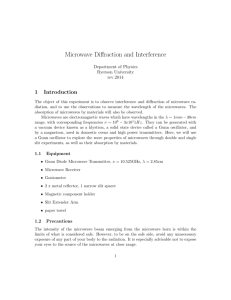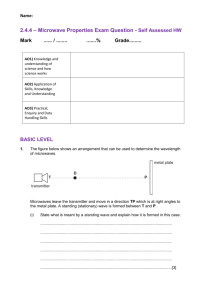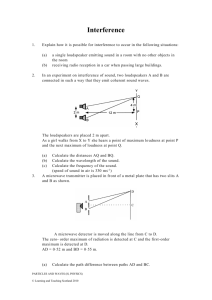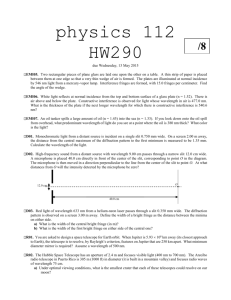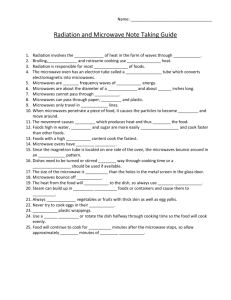MICROWAVE DIFFRACTION AND INTERFERENCE Introduction
advertisement
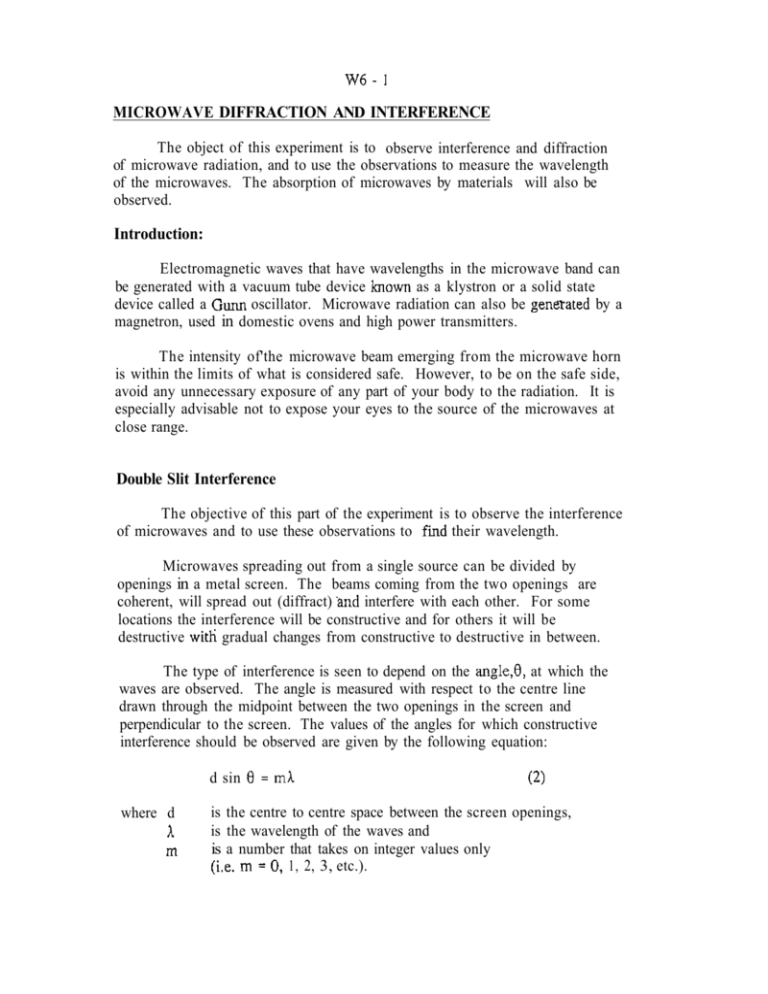
MICROWAVE DIFFRACTION AND INTERFERENCE The object of this experiment is to observe interference and diffraction of microwave radiation, and to use the observations to measure the wavelength of the microwaves. The absorption of microwaves by materials will also be observed. Introduction: Electromagnetic waves that have wavelengths in the microwave band can be generated with a vacuum tube device h o w n as a klystron or a solid state device called a Gunn oscillator. Microwave radiation can also be genetated by a magnetron, used in domestic ovens and high power transmitters. The intensity of'the microwave beam emerging from the microwave horn is within the limits of what is considered safe. However, to be on the safe side, avoid any unnecessary exposure of any part of your body to the radiation. It is especially advisable not to expose your eyes to the source of the microwaves at close range. Double Slit Interference The objective of this part of the experiment is to observe the interference of microwaves and to use these observations to f i d their wavelength. Microwaves spreading out from a single source can be divided by openings in a metal screen. The beams coming from the two openings are coherent, will spread out (diffract) -and interfere with each other. For some locations the interference will be constructive and for others it will be destructive with gradual changes from constructive to destructive in between. The type of interference is seen to depend on the angle$, at which the waves are observed. The angle is measured with respect to the centre line drawn through the midpoint between the two openings in the screen and perpendicular to the screen. The values of the angles for which constructive interference should be observed are given by the following equation: d sin 0 where d h rn = rnh (2) is the centre to centre space between the screen openings, is the wavelength of the waves and is a number that takes on integer values only (i.e. m = 0, 1, 2, 3, etc.). Procedure I. 2. 3. 4. , 5. Obtain the apparatus with the microwave generator and receiver mounted on the board with a protractor and swivel at one end. Mount the generator at the end with the protractor and set the receiver directly opposite so the units face each other. Set the screen with two openings in front of the transmitter horn and adjust the horn to screen distance so that the received power at 90' is a maximum. Adjust the gain on the amplitude to 80 p A (or a value as close to this as possible). Note that the received power is very sensitive to changes in distance between the transmitter and the horn. If possible, tape each of these in place on their stands to ensure that they do not move duriig your data taking. Record receiver meter readings as a function of angle up to about 60' on both sides of the centre. Take readings at 2' intervals. Plot the data for relative power vs. angle. Draw a smooth curve through the points. Determine the angle separating each side maximum from the centre maximum and average. Estimate the uncertainty in this angle. Measure the centre to centre separation of the two openings in the screen. Use equation (2) and the average location of the maxima to get an estimate of the microwaves' wavelength and the uncertainty of this value. Single Slit Diffraction The image of a point source passing through a small opening can be characterized as a fuzzy cental image surrounded by concentric fuzzy bands of light. The angular separation of the first dark spaces is inversely related to the size of the opening, a, and proportional to the wavelength; where k is a constant of proportionality which depends slightly on the shape of the opening. For a rectangular opening, k = 1, but for a circular opening, k = 1.22. The objective is to observe the single slit diffraction pattern and obtain a rough estimate of the wavelength of the microwave source. I. Take the screen with the 3 cm opening and mount it in front of the transmitter. Adjust the spacing of the screen and horn by sliding the base of the transmitter forward or back to obtain a maximum received power at 90'. Adjust the gain on the receiver to an amplitude of approximately 80 pa. ( These readings are a relative measure of received power so the gain must be kept constant for each set of measurements, but may be adjusted before each set.) Make measurement of received power every 2' from 90' to 150' and again from 90' down to 30'. Draw a smooth curve throuzh the points. 2. 3. 4. 5. Plot the data for relative power against angle. Repeat the measurements of I. above, using the screen with the single 1.5 cm opening placed in front of the horn and adjusted as before. Adjust the received power at 90' so that it is the same as that obtained at 90' using the double slit. Plot relative power versus angle on same graph as the double slit. Comment on any similarities between the two patterns. Estimate the angular separation, 0, of the minimum power points on each side of the central maximum for each pattern. Note that the larger opening results in a narrower pattern of received power. If possible, estimate the wavelength of the microwaves usirig the formula (1) for single slit diffraction. Absorption of Microwaves by Wet and Dry Materials The object of this part of the experiment is to observe the ability of water to absorb microwaves. Procedure 1. 2. 3. Adjust the horns to 90 and the received power to maximum. With no screens crumple a dry paper towel and place it in the receiver horn. Record the meter reading. Remove the paper towel from the horn and wet it. The towel should be damp but not dripping. Place the damp towel in the receiver horn and record the new meter reading. Compare this reading to the one with the dry towel in the horn. What can you conclude from these observations? Try other types of materials as available, plastics, cloth, etc.
